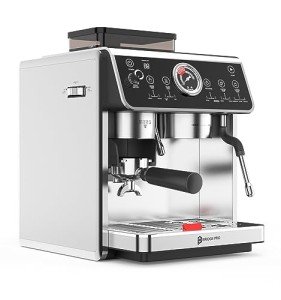Best Espresso Machines: A Comprehensive Guide
Espresso machines have become a staple in coffee culture, attracting lovers and casual drinkers alike. The best shot of espresso can raise the coffee experience, and picking the best machine is important for attaining this objective. This post dives into the world of espresso machines, exploring some of the very best options readily available on the marketplace today. It will cover the types of machines, key functions to think about, a comparison table, and regularly asked questions.
Types of Espresso Machines
Before venturing into particular items, it's important to comprehend the numerous types of espresso machines available:
- Manual Machines: Also known as lever machines, these need the user to by hand manage the pressure and flow of water. Retro Espresso Machines use a hands-on experience but demand more ability.
- Semi-Automatic Machines: These machines automate the pressure and temperature level, while enabling users to manage the shot timing. They are ideal for those who wish to take control without needing excessive effort.
- Automatic Machines: These devices automate the brewing process completely; users simply pick the size and strength of the shot. Great for beginners.
- Super-Automatic Machines: This type grinds the beans, tamps, brews, and even froths milk instantly. They're outstanding for convenience, making them appropriate for those who desire speed without sacrificing quality.
- Pill Machines: Utilizing pre-packaged coffee pods, these are the most basic machines for making espresso. While convenient, they often lack the depth of flavor discovered in newly ground beans.
Key Features to Consider
When browsing for the very best espresso machine, several essential functions must direct your decision:
- Pressure: The perfect pressure for an espresso machine is 9 bars. This pressure is crucial for drawing out flavors efficiently.
- Temperature level Control: Consistent water temperature level is crucial for an excellent espresso. Search for machines with PID (Proportional Integral Derivative) temperature level control.
- Construct Quality: Machines made from high-quality products tend to last longer and offer a better experience.
- Size and Footprint: Consider your readily available counter area. Some machines are compact, while others require considerable space.
- Grinder Quality: An integrated grinder provides benefit, but the quality of the grinder impacts the final taste. Doser or doserless types alter the taste profile substantially.
- Reduce of Use and Cleaning: Consider how simple the machine is to tidy and keep. Machines with removable parts normally offer much easier cleansing.
Contrast Table of Best Espresso Machines
Here's a contrast table showcasing a few of the most advised espresso machines based on various user reviews and professional ratings:
| Espresso Machine | Type | Pressure (Bars) | PID Control | Grinder Type | Cost Range |
|---|---|---|---|---|---|
| Breville Barista Express | Semi-Automatic | 9 | Yes | Conical burr grinder | ₤ 600 - ₤ 700 |
| De'Longhi EC155 | Manual | 15 | No | No grinder | ₤ 100 - ₤ 150 |
| Rancilio Silvia | Semi-Automatic | 9 | No | No grinder | ₤ 700 - ₤ 800 |
| Saeco Xelsis | Super-Automatic | 15 | Yes | Integrated grinder | ₤ 1,000 - ₤ 1,500 |
| Nespresso VertuoPlus | Capsule | N/A | No | No grinder | ₤ 150 - ₤ 200 |
| Gaggia Classic Pro | Semi-Automatic | 9 | Yes | No grinder | ₤ 400 - ₤ 500 |
Summary of Best Espresso Machines
- For Beginners: The De'Longhi EC155 is an outstanding beginning point due to its affordable price and ease of use.
- For Serious Enthusiasts: The Rancilio Silvia offers a balance in between quality and control, attracting those who want to refine their barista skills.
- For Convenience: The Saeco Xelsis stands apart as a top super-automatic alternative, perfect for users looking for optimum ease without compromising taste.
Regularly Asked Questions (FAQs)
Q1: What is the best pressure for drawing out espresso?A1: The perfect pressure is 9 bars; this pressure level is ideal for drawing out the tastes in espresso.
Q2: How typically should I clean my espresso machine?A2: Regular cleaning is essential. For machines with integrated mills, it is best to clean them after every use. Deep cleaning should be done weekly or regular monthly depending upon use and design.
Q3: Can I use routine coffee in an espresso machine?A3: Espresso is made from carefully ground coffee, preferably roasted particularly for espresso. While you can use regular coffee, the taste and extraction might vary.
Q4: How long can my espresso machine last?A4: With appropriate care and maintenance, a high-quality espresso machine can last numerous years, even decades.
Q5: What grinder should I use for espresso?A5: A burr grinder is more effective, as it supplies constant grind size which is essential for correct extraction.
The journey to discovering the best espresso machine can be an exciting one, filled with discovery and potential for establishing one's coffee taste buds. Whether choosing the simpleness of a capsule machine or the control of a manual model, knowing the various types and features can significantly improve the experience. With advances in technology and innovation, there's a suitable espresso machine for all preferences and skill levels on the marketplace today. Investing in the right machine not only guarantees terrific taste but likewise raises the total coffee experience.

